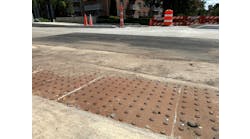ITS infrastructure, monitored at this traffic management center, has been widely deployed by the Maryland SHA.
Maryland is home to nearly 6 million people. The state’s proximity to Washington, D.C., makes the Baltimore-Washington region a site of high socioeconomic activity. The state’s overall transportation infrastructure is multimodal in nature and is connected to a host of travel activities between Maryland, Washington, D.C. and northern Virginia. The state experiences significant travel demand for pass-through traffic on the I-95 and I-81 corridors, as well as the activities at the Port of Baltimore. All these factors make the Baltimore-Washington region one of the most congested in the nation, with oversaturated travel conditions. The current and projected demand on the transportation system and funding constraints require efficient system management through innovation and technology-based solutions.
The Maryland Department of Transportation (MDOT) is responsible for managing this transportation network and strives to deliver a reliable, safe, efficient and affordable system to its residents, commuters, business community and visitors.
Through Maryland’s State Highway Administration (SHA), MDOT’s business unit that owns and operates the state highway system, intelligent transportation system (ITS) infrastructure has been widely deployed. Technologies such as closed-circuit television cameras, dynamic message signs and adaptive signal systems exponentially increase data flow to SHA, providing additional resources for the management of the transportation system. The agency’s goal in implementing ITS is to decrease travel-time variability and improve the reliability of its transportation system through a combination of planning, operations and transportation management strategies.
It’s all part of the plan
SHA’s Transportation Systems Management and Operations (TSM&O) Strategic Implementation Plan was developed through a partnership between various MDOT transportation business units and external stakeholders, including the Federal Highway Administration and local jurisdictions, to ensure diversity of opinions and experience. The plan calls for implementing strategies to leverage planning, operations and asset data for reliable customer travel experiences and improved transportation system performance. A TSM&O program leverages technology solutions, innovations and partnerships to maximize the use of existing capacity, thereby increasing system safety, reliability and efficiency. When the TSM&O Plan was published, former SHA Administrator Gregory Johnson summarized it as follows:
“It’s about making it easier for all of our customers—whether a commuter, truck driver or tourist—to travel reliably from point A to point B; it’s about creating a world-class transportation system that attracts business to our state; it’s about using new sources of data to make better, more informed decisions on transportation investments; it’s about all of these and more. But at the end of the day, it’s about meeting our customers’ expectations.”
The plan also identifies a very specific mission, vision and goals rather than discussing the general process for efficient management of the transportation system. The TSM&O Mission and Vision align closely with Johnson’s description while the goals attempt to identify specific metrics of improvement for the process as well as to measure success:
- Goal 1: Develop and implement a sustainable TSM&O program at MDOT SHA;
- Goal 2: Improve travel-time reliability for both people and freight on freeways and arterials;
- Goal 3: Develop data- and performance-driven approaches to support TSM&O planning, programming, implementation and evaluation decisions; and
- Goal 4: Improve the travelling public’s experience on Maryland highways by enabling customers with information and choices.
For each of these goals, the MDOT SHA TSM&O Strategic Implementation Plan includes specific objectives, strategies, actions, responsibilities and implementation timeframes. There are a total of 10 objectives, spanning from two or four per goal, and under each objective there are one to five strategies and actions to be completed to ultimately meet the goals of the TSM&O Strategic Implementation Plan.
A key success factor for TSM&O implementation is to ensure that there is an organizational structure within MDOT SHA to provide oversight of the TSM&O Strategic Implementation Plan, in conjunction with both internal and external stakeholders. The plan proposes an organizational setup for TSM&O within MDOT SHA including the creation of a new TSM&O program manager position to facilitate institutional and programmatic TSM&O strategy integration within existing MDOT SHA offices. The identification of specific SHA staff to champion the implementation of TSM&O provides accountability and coordination points for systematic use of the TSM&O Strategic Plan. Each champion’s goal is to meet the objectives outlined for their respective goal.
The impact on transportation management
MDOT SHA gained momentum implementing innovative strategies through the development of the TSM&O plan. Since publication of the document in the summer of 2016, several programs have revised their scopes of work to fit within the TSM&O strategy. One such program involves the implementation of connected-vehicle technology infrastructure. The U.S. 1 corridor in Howard County previously implemented adaptive signal-control technology and will soon be adding additional ITS technology and data-management architecture to ensure a more robust communication infrastructure.
The ultimate goal is to understand the impacts of these ITS technologies to MDOT SHA and the traveling public, and how the data should be governed and processed. The U.S. 1 corridor program also will likely include Dedicated Short Range Communication (DSRC) technology to test connected-vehicle communication with signals and other transit or weather-related information.
In the realm of transportation planning, travel time and speed data historically relied on manually collected floating car travel runs to monitor vehicular flow. The Office of Planning and Preliminary Engineering (OPPE) has migrated to more comprehensive data products enabled by Bluetooth, Wi-Fi sensors and vehicle probe speed available through private-sector tools. The Regional Integrated Transportation Information System (RITIS.org) online platform developed by the University of Maryland Center for Advanced Transportation Technology (UMD CATT) Lab and the Vehicle Probe Project (VPP) Suite applications, initially developed for the I-95 Corridor Coalition members, have changed the way OPPE utilizes speed, travel time and incident data to communicate impacts to decision makers. The UMD CATT Lab serves as the travel and incident data repository and regional coordination interface for the region with state-of-the-art applications, all of which helps to further support TSM&O through accurate and reliable data streams. Without the capability to search, manipulate and share data in a relatable way, TSM&O’s success may be impeded.
As a whole, MDOT SHA also has developed enterprise GIS (e-GIS)-based applications and dashboards where planning, operations and asset data from various offices have been linked through sound data-governance practices to support performance management and investment decisions. Through the use of ITS, new terms, such as “reliability,” have been incorporated into decision-making vernacular instead of being “pie in the sky” metrics.
Reliability performance strategies were initially developed through the Reliability Roadmap report. Today, project planning studies systematically report travel-time indices (TTI) or planning-time indices (PTI) to ensure recurring and non-recurring congestion impacts are taken into consideration. This approach has consistently provided positive feedback and given data-driven decisions more weight, as reliability often speaks to the reason behind congestion, which oftentimes is not captured through “typical day” microsimulation analysis.
The RITIS platform and VPP Suite have changed how speed, travel time and incident data are used to communicate impacts.
Success is ongoing
TSM&O is not a new concept for state DOTs, the Federal Highway Administration or anyone involved in the monitoring of transportation facilities. It stems from the desire to effectively use resources to satisfy the public’s needs and stimulate the movement of goods and people. Within MDOT, the foundation for the TSM&O Strategic Implementation Plan is built upon programs such as the Coordinated Highways Action Response Team (CHART) and the MTA’s robust incident-management program. The MTA’s Intercounty Connector (ICC) supports electronic toll collection (ETC) through video and EZ-Pass while the Bay Bridge provides reversible-lane systems for increased mobility.
To increase innovation, programs must continuously evolve and adapt while still remaining cost-effective. Newly proposed strategies in MDOT SHA include wider visual monitoring of our transportation system through the use of advanced CCTV cameras, vehicle-detection sensors spaced at predetermined intervals across all major highways, and intermodal parking monitoring. These strategies have one goal in mind—more data.
However, data is only useful if a communication network exists that is capable of efficiently transferring the data from the field back to SHA. A significant portion of ITS implementation relies on a robust network of fiber and wireless communications. MDOT SHA is currently developing a Communication Strategic Plan to evaluate how data could be moved across corridors to and from the ITS infrastructure necessary to sustain connected and autonomous vehicles, both for MDOT’s monitoring of the transportation network and to inform the traveling public. A key factor in the development of this plan is the cost of data transfer. The advent of wireless technology brought about significant change in how much data we can collect, which in turn results in significant cost to users, such as state DOTs, who wish to transfer data from one point to the next. The expected goal of this Communication Strategic Plan is a base network of communications infrastructure which ITS technologies can tap into—further stimulating growth and mobility throughout Maryland, at a cost sustainable by the state DOT. The improved reliability of a statewide communication network could help feed the increasingly complex ITS tools and support connected and autonomous vehicles, thus enabling MDOT to meet its core mission: A customer-driven leader that delivers safe, sustainable, intelligent and exceptional transportation solutions in order to connect all users to life’s opportunities.
---------------
Delion is a traffic engineer in the data services engineering division of the Maryland State Highway Administration.



